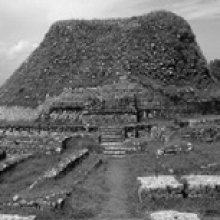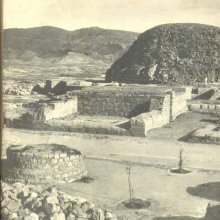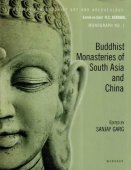Dharmarajika, Dharma-rajika, Dharmarājikā: 6 definitions
Introduction:
Dharmarajika means something in Hinduism, Sanskrit, the history of ancient India. If you want to know the exact meaning, history, etymology or English translation of this term then check out the descriptions on this page. Add your comment or reference to a book if you want to contribute to this summary article.
Images (photo gallery)
India history and geography
Source: Cologne Digital Sanskrit Dictionaries: Indian Epigraphical GlossaryDharmarājikā.—(IA 14; ML), Buddhist; a stūpa built on the relics of the Buddha called Dharmarāja; a Buddhist stūpa. Note: dharmarājikā is defined in the “Indian epigraphical glossary” as it can be found on ancient inscriptions commonly written in Sanskrit, Prakrit or Dravidian languages.

The history of India traces the identification of countries, villages, towns and other regions of India, as well as mythology, zoology, royal dynasties, rulers, tribes, local festivities and traditions and regional languages. Ancient India enjoyed religious freedom and encourages the path of Dharma, a concept common to Buddhism, Hinduism, and Jainism.
Languages of India and abroad
Sanskrit dictionary
Source: DDSA: The practical Sanskrit-English dictionaryDharmarājikā (धर्मराजिका).—a monument, a stūpa (Sārnāth Inscrip. of Mahīpāla; Ind. Ant. Vol.14, p.14.)
Dharmarājikā is a Sanskrit compound consisting of the terms dharma and rājikā (राजिका).
Source: Cologne Digital Sanskrit Dictionaries: Edgerton Buddhist Hybrid Sanskrit DictionaryDharmarājikā (धर्मराजिका).—once dhārm° (from dharmarājan 1), [Page281-a+ 71] lit. (edifice) which belongs to (serves for relics of) the king of the doctrine (= Buddha); a stūpa. So correctly [Boehtlingk and Roth]; Burnouf Intr. 370 n. 1 and 631 is uncertain; Divyāvadāna Index wrongly royal edict on the law. The meaning seems clear from (caturaśīti-) dharmarājikā-sahasraṃ pratiṣṭhāpayeyam Divyāvadāna 381.14, °sraṃ pratiṣṭhāpitam 18, 23, while in the same passage, describing the same performance, in verse, we read: cakre stūpānāṃ…sāśīti…sahasram 21. To my mind this settles the matter. Other occurrences, always with forms of pratiṣṭhāpayati, establishes, founds: Divyāvadāna 379.22; 381.5; 402.19; 405.15, 16; 419.15; 429.13; 433.27; 434.1; also dhārmarājikā 368.28.
--- OR ---
Dhārmarājikā (धार्मराजिका).—q.v.: Divyāvadāna 368.28.
Dhārmarājikā can also be spelled as Dharmarājikā (धर्मराजिका).
Source: Cologne Digital Sanskrit Dictionaries: Monier-Williams Sanskrit-English DictionaryDharmarājikā (धर्मराजिका):—[=dharma-rājikā] [from dharma > dhara] f. a Stūpa, [Buddhist literature]
[Sanskrit to German]
Sanskrit, also spelled संस्कृतम् (saṃskṛtam), is an ancient language of India commonly seen as the grandmother of the Indo-European language family (even English!). Closely allied with Prakrit and Pali, Sanskrit is more exhaustive in both grammar and terms and has the most extensive collection of literature in the world, greatly surpassing its sister-languages Greek and Latin.
See also (Relevant definitions)
Partial matches: Dharma, Rajika, Tarma.
Ends with: Agra-dharmarajika.
Full-text: Agra-dharmarajika, Dharmaraja, Rajika.
Relevant text
Search found 5 books and stories containing Dharmarajika, Dharma-rajika, Dharmarājikā, Dharma-rājikā, Dhārmarājikā, Dharmarājika, Dharmarājika, Dharma-rājika; (plurals include: Dharmarajikas, rajikas, Dharmarājikās, rājikās, Dhārmarājikās, Dharmarājikas, rājikas). You can also click to the full overview containing English textual excerpts. Below are direct links for the most relevant articles:
Settlement in Early Historic Ganga Plain (by Chirantani Das)
Part 11 - Main Shrine of Sārnāth < [Chapter VII - Sārnāth: The Satellite Religious Centre]
Part 14 - Dharmarājika stūpa < [Chapter VII - Sārnāth: The Satellite Religious Centre]
Part 8 - Layout of the Archeological site (of Sārnāth) < [Chapter VII - Sārnāth: The Satellite Religious Centre]
Stupas in Orissa (Study) (by Meenakshi Chauley)
Anāgārika Dharmapāla (by Bhikkhu Sangharakshita)
The Life of Sariputta (by Nyanaponika Thera)
Vietnamese Buddhist Art (by Nguyen Ngoc Vinh)
1. The evolution of Buddhist Art (Introduction) < [Chapter 1 - The evolution of Buddhist Art in South Vietnam and South East Asia]
Related products


